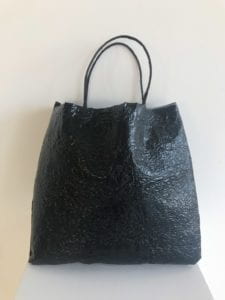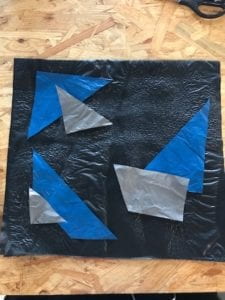The Pleather Bag



Project Statement
Many people perceive trash or waste as something that is unappealing, unattractive and meant to be thrown away. The Pleather Bag aims to highlight the potential for plastic waste to be transformed into something beautiful, functional and fashionable. Through ironing techniques to fuse sheets of plastic waste together, durable, leather-like fabric was created to transform what were once single-use objects into a bag that can be worn over and over again.
Research
In a study conducted to determine what kind of environmental activist art is the most effective in inspiring proenvironmental behavior, Sommer and Klöckner found that works that offered solutions, rather than just the presentation of a problem, had the most potential to influence audience behavior. Their research findings served as motivation for me to produce a wearable that was as, well, wearable, as possible. If waste can be transformed into something both functional and beautiful, others will perhaps be inspired to do the same.
As for the material, I was largely inspired by the ironing experiment in class. Fused plastic can look almost leather-like, which makes sense for a bag considering a lot of bags are made out of leather.
Because I was pretty new to creating wearables, I referenced Nicole Gdula’s bag for the sewing technique in terms of sewing the sides and bottom of two sheets of material together before flipping them inside out so that the seam is hidden.
Significance
This project shows the potential for plastic waste as a material in the realm of fashion rather than just as a form of waste. Trash does not have to look like trash. The project is also very easily replicable: it does not take too much skill since you would only need to learn the ironing technique and how to use a sewing machine (to sew simple straight lines), and there is a lot of room for creativity with the design of the bag. The variety of material and tools used is also relatively small; all you need is an iron, baking paper, plastic bags or plastic packaging, and sewing materials.
Design
Since the main goal was to create something that would be deemed as fashionable, I drew my main design inspiration from Issey Miyake’s bags.


I love the geometric style of his bags, and the popularity of these bags serve as a kind of market confirmation that this kind of geometric aesthetic is something a lot of people also find appealing.
Based off of this aesthetic, I sketched an initial idea of how I visualized my bag:

This design evolved as I went into production mode, the details of which are discussed below.
Production
I started off by making the two layers of material that would become the body of the bag. The raw plastic material I used was largely influenced by the color I wanted (black), and ended up being the packaging that a lot of companies use to ship or deliver their non-fragile products, such as clothing, in. The size of the bag was, in turn, affected by how large this raw material was.
I folded and cut four layers of the raw plastic material before fusing it at 120 degrees with an iron, the temperature of which was decided because of the experiment Maya and I conducted a few weeks prior in class. The result was a leather-like material:

The next step was to create the geometric patterns on top of one of the new fabric layers. I was originally going to sew new created fabric on top, but Professor Marcela showed me bags from the company Up-Fuse, who fuse the layers on top instead. This was definitely a lot quicker and simpler than what I was planning to do.

pre-iron

post-iron
The pattern that I decided on was a bit different from the one I originally sketched out. This was a combination of experimenting with shapes and how they looked and the fear of not being able to iron on the shapes perfectly straight. If they were purposely slanted, this would be a lot easier and look better should the shapes shift if I accidentally moved them around before they were completely fused. In hindsight, this decision makes the design more easily replicable because there is no need for perfection.
To sew the two sheets of material together, I referenced Nicole Gdula’s project in sewing the sides and bottom before flipping the bag inside out to get a cleaner seam.

The most challenging part of this project was the handles. At first, I planned to stuff strips of fused plastic with bubble wrap in a tube-like manner, and then fusing these handles to the bag. However, when I tried to do this the “pleather” material wrinkled very strangely when it was folded; it didn’t feel natural to hold like a bag. I ended up using bag handles from a Lelecha paper bag instead, but with this decision rose another challenge: how to attach it to the bag. I wanted to try and do this without any sewing techniques. I experimented with two ways of the fusing technique to trap the handle in the plastic, but this was not very strong. I ended up sewing the handles to smaller strips of the pleather, and then fusing that pleather to the main body of the bag:


Conclusion
This project is far from perfect, but I think the main goals were achieved: a bag was created out of trash without looking like trash, in a way that is easily replicable in order to inspire others to upcycle their plastic waste. With a geometric design inspired by Issey Miyake, this kind of geometric aesthetic hopefully aligns with many other’s concept of what is fashionable.
There are certainly many imperfections, such as how the edges are not as clean as they could be. I also wish I spent more time on transforming the handles. By simply taking handles from an existing paper bag, even if it is an example of reusing material, this material has not been creatively transformed. The main body of the bag shows that plastic packaging can be transformed into a material that looks and feels completely different, yet the handles of the bag have not been transformed to the same degree.
If sewing could be entirely replaced by the fusing technique, this would also be more ideal, removing the need for sewing skills (making it more easily replicable), and removing any non-recycled material (the thread).
If anything, my hope is for anyone who views this project to also think about these areas of improvement so that they can not only replicate the bag, but improve upon its design as well.
Leave a Reply